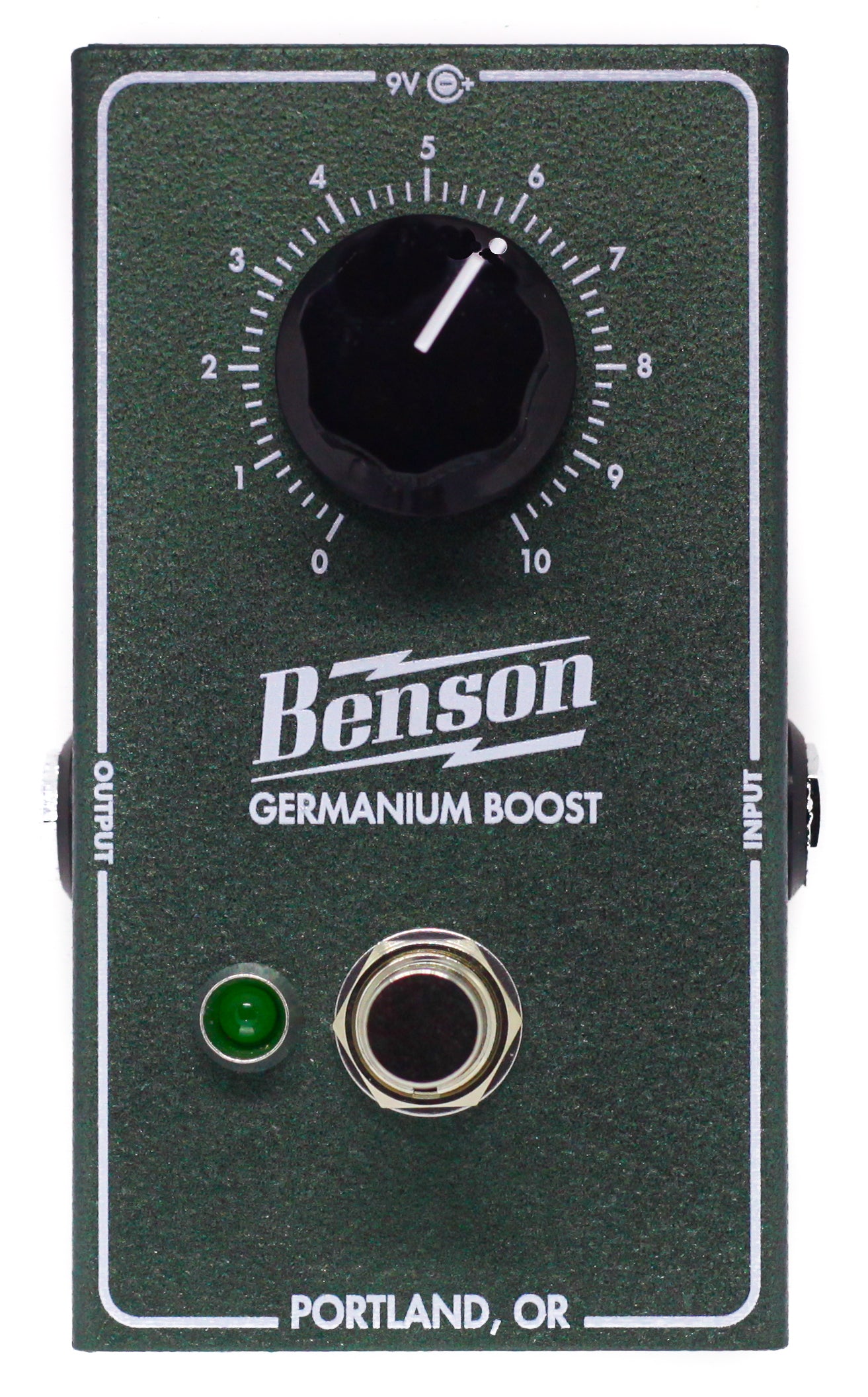
- Details
- Reviews
When designing the temperature-controlled fuzz, Benson Amp's explored some unconventional approaches. One of the ideas they experimented with involved using a voltage-controlled error-correcting circuit to bias a single germanium transistor. However, this approach ultimately didn't work for the fuzz, as the circuit proved to be overly sensitive to the gain characteristics of the transistor.
Despite this, Benson Amp's found a new purpose for the circuit.
It turned out to be perfect for creating a germanium clean boost that, like their fuzz, is immune to component drift, leakage, and temperature fluctuations—and even more so in this case. They also solved several issues that had previously hindered the use of germanium transistors for a convincing linear boost. Benson Amp's increased the input headroom (since even a standard guitar signal can drive a germanium transistor into unwanted distortion without adjustments) and raised the input impedance (as a standard BJT transistor typically thins out bass frequencies and reacts negatively to the signal feeding into it).
The result is a germanium clean boost that allows the use of a germanium transistor without the unwanted artifacts that were once considered inherent to the design—namely temperature sensitivity, drift, and less-than-ideal input impedance and headroom.
When the boost is first powered on, it takes about 10 seconds for the error-correction circuit to properly bias the germanium transistor. After that, things get interesting. Benson Amp's discovered how the boost makes guitar signals sound more musical, even at the same volume as the bypassed tone. It enhances the attack of the guitar while simultaneously smoothing out the notes, almost like a compressor—but with a unique twist. It's difficult to describe, but it seems to eliminate the undesirable aspects of a signal while emphasizing the good ones. It’s particularly effective on bass, helps acoustic guitar pickups sound more natural, and, of course, will push any amp into a frenzy.
Benson Amp's hopes players enjoy it.
POWER SUPPLY
This pedal is designed to be powered by a 9V DC Boss-style center-negative power supply. There is also space for a battery, which activates when a cable is plugged into the input and no external power supply is connected to the DC jack.
Please do not use a power supply providing more than 9V DC, as this could damage both the pedal and the power supply.
| Product Name | Benson Amps Germanium Boost Pedal |
|---|---|
| Brand | Benson Amps |
| Condition | New |
| MPN | BA-BOO |
| UPC | 860044002673 |
| Shipping Option | Free Shipping to the Continental U.S. |
Benson Amps Germanium Boost Pedal
When designing the temperature-controlled fuzz, Benson Amp's explored some unconventional approaches. One of the ideas they experimented with involved using a voltage-controlled error-correcting circuit to bias a single germanium transistor. However, this approach ultimately didn't work for the fuzz, as the circuit proved to be overly sensitive to the gain characteristics of the transistor.
Despite this, Benson Amp's found a new purpose for the circuit.
It turned out to be perfect for creating a germanium clean boost that, like their fuzz, is immune to component drift, leakage, and temperature fluctuations—and even more so in this case. They also solved several issues that had previously hindered the use of germanium transistors for a convincing linear boost. Benson Amp's increased the input headroom (since even a standard guitar signal can drive a germanium transistor into unwanted distortion without adjustments) and raised the input impedance (as a standard BJT transistor typically thins out bass frequencies and reacts negatively to the signal feeding into it).
The result is a germanium clean boost that allows the use of a germanium transistor without the unwanted artifacts that were once considered inherent to the design—namely temperature sensitivity, drift, and less-than-ideal input impedance and headroom.
When the boost is first powered on, it takes about 10 seconds for the error-correction circuit to properly bias the germanium transistor. After that, things get interesting. Benson Amp's discovered how the boost makes guitar signals sound more musical, even at the same volume as the bypassed tone. It enhances the attack of the guitar while simultaneously smoothing out the notes, almost like a compressor—but with a unique twist. It's difficult to describe, but it seems to eliminate the undesirable aspects of a signal while emphasizing the good ones. It’s particularly effective on bass, helps acoustic guitar pickups sound more natural, and, of course, will push any amp into a frenzy.
Benson Amp's hopes players enjoy it.
POWER SUPPLY
This pedal is designed to be powered by a 9V DC Boss-style center-negative power supply. There is also space for a battery, which activates when a cable is plugged into the input and no external power supply is connected to the DC jack.
Please do not use a power supply providing more than 9V DC, as this could damage both the pedal and the power supply.
| Product Name | Benson Amps Germanium Boost Pedal |
|---|---|
| Condition | New |
| MPN | BA-BOO |
| UPC | 860044002673 |
- Choosing a selection results in a full page refresh.
- Opens in a new window.

